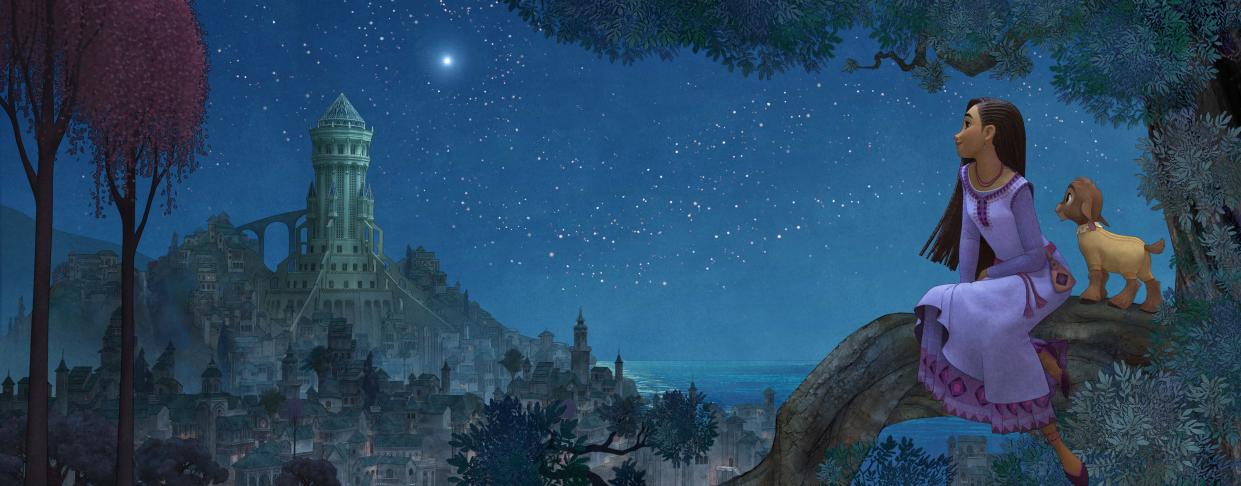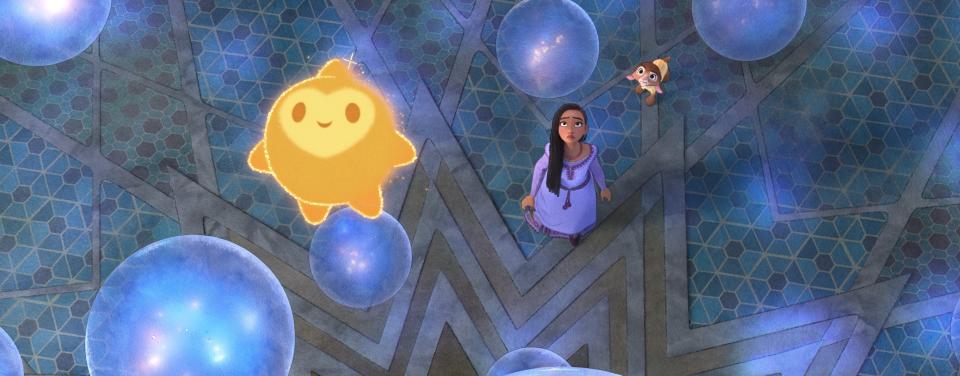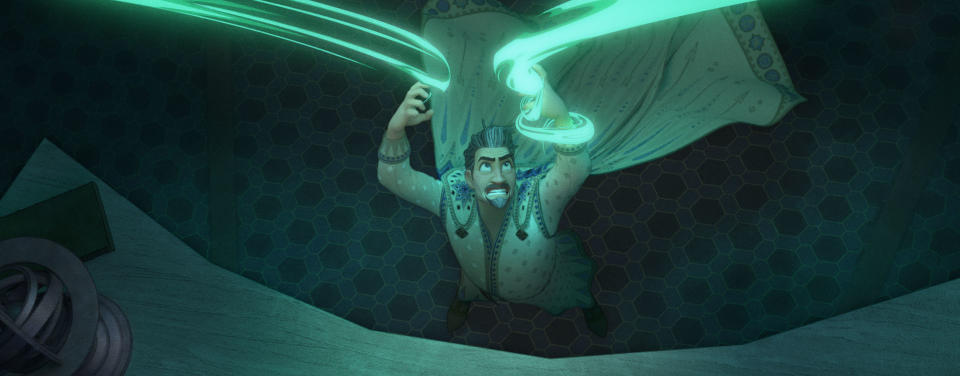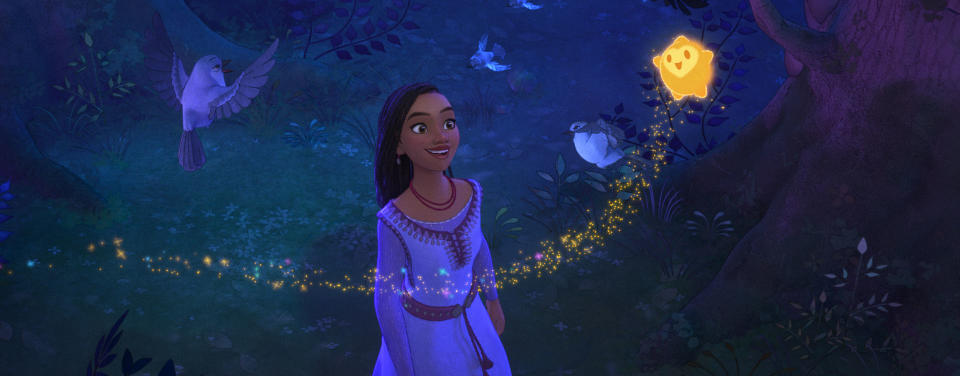With Its Revival of 2D, ‘Wish’ Became a ‘Gateway Drug’ for Young Disney CG Animators

- Oops!Something went wrong.Please try again later.
- Oops!Something went wrong.Please try again later.
- Oops!Something went wrong.Please try again later.
With “Wish,” Disney Animation celebrates its 100th anniversary by merging the 2D legacy of watercolor background paintings (dating back to “Snow White and the Seven Dwarfs”) with cutting-edge CG. The result was a revitalization of the retro aesthetic in every department to better display the hand of the artist. Like a gateway drug, it has already carried over into an as-yet-unannounced feature with a very different 2D look.
The musical fantasy (directed by Chris Buck and Fawn Veerasunthorn) was the perfect storm for a convergence of the past and present, as it pays tribute to Walt’s beloved wishing star — symbolic of his ethos about the importance of hopes and dreams. Asha (Ariana DeBose), a 17-year-old very much in the mold of the modern Disney heroine, desperately wishes upon a star to save her medieval kingdom of Rosas when Sorcerer King Magnifico (Chris Pine) imprisons their wishes. Asha’s plea is answered with the arrival of Star, a mischievous, cosmic character, who offers to guide her.
More from IndieWire
Robert De Niro Blasts Apple and Gothams for Editing His Anti-Trump Speech on Teleprompter
'Past Lives' Wins Gotham Award for Best Feature (Complete Winners List)
“The idea of being able to combine the two [techniques] so you had no loss in translation was a commitment we made even before we knew how we were going to do it,” Jennifer Lee, Disney Animation’s chief creative officer and “Wish” screenwriter, told IndieWire. “There’s always a loss in translation from what the artists want to achieve. And we [could] finally remove that to celebrate the artists’ vision and brushstroke, but also have it built in every single plane and layer of the film, so that you get to be as immersed in CG as you want.”
The embrace of Walt’s watercolor fairy tale world began with production designer Michael Giaimo (“Frozen”), who dug into Disney’s first two animated features — “Snow White” and “Pinocchio” — at the Animation Research Library. This led to an exploration of the background designs of art director Gustaf Tenggren, an acolyte of Swedish painter/illustrator John Bauer, who Walt first wanted for “Snow White” but died during prep. “I connected all those dots to the Disney legacy, to Walt Disney’s childhood history,” Giaimo told IndieWire, “and I thought that the look that all those illustrators employed at that time was a watercolor look, which I recommended to Chris [Buck], who wanted to honor the art in this. But not watercolor with loose pools of water all over the place; a watercolor look that was very confined, controlled within itself but also the linework. That defined both characters and environment. So we thought, ‘Let’s try to leverage that look for ‘Wish.'”

Giaimo re-teamed with “Frozen” production designers Lisa Keene and David Womersley to collaborate on the entire Mediterranean world of Rosas. “Because of a watercolor look, we wanted crispness and clarity,” he continued. “But we had to find out if we could do it creatively for a whole movie. We actually took a Tenggren dead background from ‘Pinocchio’ and put a CG Asha in it. It was a very early test, and we gave her a treatment, just to see if she could fit into a watercolor world. And it worked, it melded really well.”
This treatment of Asha, however, meant extending the watercolor look to the characters. They required additional hand-drawn linework or texturing through a projection method of compositing. This was especially true of Star, who evolved from a human to a shapeshifter to a ball of energy to, finally, a caricatured star with a Mickey Mouse-influenced mask.
“It’s very challenging to take a character and give it a treatment because the character’s really moving, the camera’s moving, but the background is fixed and that changes the background,” added Giaimo. “But we didn’t use depth of field like other CG movies to retain the watercolor look. It could throw the background out of focus. But the character is defined by the line, and, as they stepped back, we would drop the line. That helped create a depth of field.”
A static image was very manageable, but figuring out how to move dimensionally through the watercolor backgrounds proved challenging. For that, they simulated the old multiplane camera effect from Walt’s traditional animation era. This created an illusion of depth by moving several layers of artwork at different speeds. “A lot of our camera moves were really 2D multiplane in terms of how we used planes of space, how we used layers,” Giaimo said. “We called that ‘layers of interest,’ stepping you back.”

The unsolved problem going into “Wish,” though, was finding a solution for providing a consistent look to the watercolor pigment and paper texture when moving through space. This was particularly important for the musical dance sequences. The team had previous success bringing out the line work in the Oscar-winning shorts “Paperman” and “Feast”, as well as the watercolor CG short “Far From the Tree.” This was achieved with Meander, the Academy Sci-Tech award-winning hybrid drawing tool, which art-directed the line art, frame-by-frame.
But “Wish” required a game-changer. Fortunately, VFX supervisor Kyle Odermatt and the tech team found the answer in a system that provided consistency by calculating texture pattern in terms of distance on a per-frame basis. They called it “Dynamic Screen Space Texturing.” The first step was putting a layer of watercolor paper texture over the top of the initial digital paintings to provide a unifying impression that the whole thing was painted on watercolor paper.
“Essentially, what it does is, if something’s further away, it calculates and applies a texture pattern to it that’s larger,” Odermatt told IndieWire. “So that when it comes back through the camera, it feels like it’s consistent with the texture size of something that’s closer to the camera. Everything is depicted in very fine detail. And so it was coming up with a whole series of systems and special and stacked filtering that would allow us to take regions that we did not want the viewer to look at, and accumulate them into the feel of a broad wash of watercolor, despite there being rendered detail in that area.
“There are so many different tricks,” he continued. “There’s even things that take that perfect CG lighting that wraps around form and breaks it up into ways that are like paint strokes or different regions of watercolor wash. Or we would render out not just the color render itself but a whole bunch of other passes that we would use to manipulate the imagery into having a sense of edge pooling or light breakup.”

In addition, effects designer Dan Lund created a rule book for the magic effects of Magnifico and Star that were traditionally animated in Harmony software. These effects, evocative of the sorcery in “Snow White” “Sleeping Beauty,” and “The Little Mermaid,” were handed over to the VFX team, which translated the 2D design language into finished CG shots. Some even remained as Lund’s 2D animation.
“Magnifico’s sort of benign magic at the beginning is mostly a color palette of whites and light blues, and, as he gets corrupted by the power of the dark magic book, you have those swooping shapes of cyan to them,” added Odermatt. “And one of the cool things is where we use that same design language, but apply it to CG style effects, where we do volumetric rendering, like the cauldron of smoke or steam.”
Another effect was the torch fire volumetric simulation, where they used neural style transfer, the AI machine learning process developed by Disney Research that calculates how the volume would be represented in terms of a particular style of whatever image you give it. Disney’s “Raya and the Last Dragon” used neural style transfer for the trippy light effects and Pixar’s “Elemental” employed it for the look of the fiery Ember.
The challenge for Lund was in designing an emotional arc for Magnifico’s dark magic (based on a claw motif for crushing wishes), as well as a signature look for Star’s playful magic (inspired by iconic Disney effects and ’60s Pop Art). “For me, the dark magic was influenced by Ursula [summoning a pair of hands from her cauldron] and stealing Ariel’s voice,” Lund told IndieWire. “The wrist goes in, the hand disappears and then reforms and comes out. So we call it the flow, and it can be solid…but it can go away like smoke when we need it to.”

Lund highlighted every point on Star and then hand-animated the cross glints (including the particles). “Then they put it into the rig, and they could trigger them when they wanted,” Lund said. “And we had a library of cross glints to have personality or attitude. There were sentimental glints and whiz-bang glints for the [‘I’m A Star’] transformation in the forest.” This was highlighted by the 2D concept of the leading edge line and proved useful in keeping Star on model.
Every single artist in the effects department got to work on Star as their first shot, which the young CG artists enjoyed because it gave them their first opportunity to animate in 2D. “Star was their gateway drug,” Lund said. “And they got a taste of what it was really like to direct their scene and the emotions and have it support what the character animators were doing. And then they took that, and they put it into all their other effects that weren’t Star-related.”
“Wish” is currently in theaters.
Best of IndieWire
Martin Scorsese's Favorite Movies: 80 Films the Director Wants You to See
The Best Animated Series of All Time: 'Daria,' 'Cowboy Bebop,' 'Scott Pilgrim Takes Off,' and More
The 62 Best Animated Movies of the 21st Century, from 'Marcel the Shell' to 'The Boy and the Heron'
Sign up for Indiewire's Newsletter. For the latest news, follow us on Facebook, Twitter, and Instagram.

